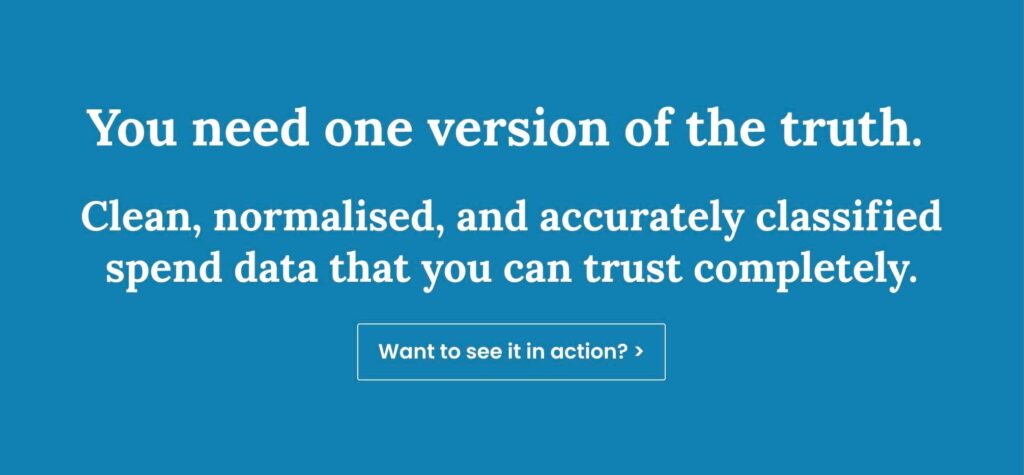
Spend Classification Series – 5-part guide
Previous: Building a Taxonomy People Actually Use (Part 3)
Next: Part 5 – Implementation & Governance
Twelve months after a shiny classification go-live, one global retailer found its “Other” bucket had doubled. The taxonomy hadn’t been updated, supplier aliases crept back in, and auditors flagged inconsistent codes across business units. All the cleansing, taxonomy design, and stakeholder workshops from year one were at risk of unravelling.
If you’ve followed Parts 1-3, you now have clean data, a business-friendly taxonomy, and the urge to automate. Today we’ll show how rule-based mapping, machine-learning models, and a human-in-the-loop review combine to keep accuracy above 95 percent, without burying analysts in endless re-coding. By the end, you’ll know exactly when to trust AI, when to rely on domain experts, and how to set confidence thresholds that scale.
Automated Spend Classification Techniques: Rules, Machine Learning & Human Review
The engine of spend-classification rests on a layered blend of rules, machine learning, and expert review.
Rule-Based Spend Mapping: The Foundation Layer
Start with rule maps: deterministic look-ups that assign a category whenever a known supplier, GL code, or keyword appears.
Because the signal is explicit, a stationery vendor always maps to Office Supplies, rules reliably tag 60–70 percent of lines on the first pass.
They shine in stable datasets and with single-category suppliers, delivering a fast, low-maintenance win.
Machine Learning for Procurement Data: Capturing the Long Tail
Next comes supervised machine learning. Here, an algorithm studies thousands of previously labelled transactions and learns to predict a category from the free-text description, price pattern, or multi-category supplier profile.
ML excels at the “long tail” of mixed or poorly described spend, typically lifting coverage by another 20–30 percent.
It is ideal for high-volume environments where new suppliers and products arrive weekly, outpacing the speed at which humans can write rules.
Rules handle the obvious. Algorithms handle the patterns. Humans handle the impossible. The key is knowing which is which.
Human-in-the-Loop Spend Classification: Expert Review Process
Finally, retain a human review loop for the edge cases: high-value invoices, ambiguous lines, or transactions that fall below a confidence threshold.
Analysts correct these records, feeding the fixes back into the training set so the model improves over time. This manual layer usually mops up the last 5–10 percent of items, ensuring sensitive spend is never mis-categorised.
Layered together, the techniques create a self-reinforcing cycle: rules do the heavy lifting, machine learning captures nuance, and experts police the grey area.
The result is >95 percent accuracy with a fraction of the human effort, exactly the scale and precision procurement analytics demands.
Understanding these three techniques is one thing, orchestrating them into a seamless workflow is another. The magic happens when you design a process that lets each method do what it does best, without overwhelming your team with manual exceptions.
Human-in-the-Loop Spend Classification: A 4-Step Workflow for 100%+ Accuracy
Even the best algorithm needs a back-stop. A well-designed human-in-the-loop (HITL) workflow keeps scale and accuracy in balance by giving machines most of the work and reserving human expertise for the tricky edge cases.
Step 1: Automated Spend Classification with Confidence Scoring
Every new transaction flows through the rule layer and the trained ML model. The system returns a category plus a confidence score, a probability, usually between 0.00 and 1.00, that the label is correct. Scores above a pre-set threshold (commonly 0.80) are assumed reliable; those lines can be stamped “final” without further touch.
Step 2: Exception Queue Management for High-Risk Transactions
Anything that falls below the confidence threshold or exceeds a financial risk limit (e.g., invoices over AUD 50 000) drops into an analyst queue. Picture a dashboard lit up like traffic lights: green rows glide straight to the data mart, amber rows cluster at 0.50–0.79 confidence waiting for review, and red rows flag high-value items that demand immediate scrutiny. This visual triage lets analysts focus on what truly matters.
Step 3: Analyst Review and Correction Capture Process
Reviewers open the amber and red items, inspect supporting detail (supplier history, description text, cost centre) and either confirm or correct the category. Crucially, every correction is captured as a labelled example. Over time the review team becomes a mini “data-annotation factory,” producing high-quality training data without extra overhead.
Step 4: Model Retraining for Continuous Improvement
On a weekly or monthly cadence, choose frequency based on transaction volume, the new labelled records feed back into the model.
Fresh data from the long tail of spend (think new suppliers, seasonal SKUs, or evolving service descriptions) teaches the algorithm to recognise patterns it previously missed. With each cycle, auto-classification coverage creeps upward and the amber queue shrinks, trimming manual effort without sacrificing control.
The payoff is compound: rules secure the obvious wins, machine learning captures nuance, and human insight seals accuracy. Together they form a virtuous loop that holds classification above 95 percent, even as suppliers, products, and market language evolve.
The best classification systems don’t just process data, they learn from their mistakes. Every human correction becomes tomorrow’s automatic win.
This four-step cycle works beautifully in theory, but success hinges on getting one critical detail right: where exactly do you draw the line between automatic approval and human review?
Spend Classification Confidence Thresholds: Balancing Automation and Manual Review
Understanding Machine Learning Confidence Scores in Procurement
Every auto-classified line carries a confidence score, the model’s statistical gut-check on its own prediction.
A score of 0.92 signals the algorithm sees a near-certain pattern match; nine times out of ten, lines in that range withstand human scrutiny. At 0.55, certainty drops to a coin-flip, some features fit the target category, others hint elsewhere. Scores this low belong in the analyst queue, not in the final dataset.
Confidence scores aren’t just numbers, they’re your algorithm’s way of saying ‘I need help.’ The magic happens when machines know what they don’t know.
Three-Tier Classification System: Green, Amber, Red Thresholds
Many programmes settle on a three-band rule. Examples are provided below:
- ≥ 0.80 – Green: auto-approve. Historical testing shows errors here are rare enough to live with, and the productivity gain outweighs the risk.
- 0.50 – 0.79 – Amber: queue for review; the model isn’t sure, but a quick human scan can tip the balance.
- < 0.50 – Red: send straight to manual classification. Patterns are too weak, or the invoice is too unusual, for machine judgment.
Cost-Risk Analysis: Calculating Manual Review Workload
Choosing the cut-off is ultimately a cost–risk trade-off. A simple way to visualise it is:
Manual lines = Total lines × (1 – Auto-threshold accuracy)
Suppose you process 1 000 000 lines per year and historical testing shows the model is 83 % accurate at the 0.80 threshold. Manual workload becomes 1 000 000 × (1 – 0.83) = 170 000 lines.
If an analyst can clear 800 lines a day, you need roughly one full-time analyst rather than the four it would take without automation. Lower the threshold and workload rises; raise it and you push risk onto dashboards.
The sweet spot is where manual effort, audit comfort, and savings all align, most teams find that hovers, Goldilocks-style, around the 0.80 mark (See Part 3 for more detail on this).
Automation without human judgment is chaos. Human judgment without automation is expensive. The sweet spot is where both know their lane.
While these principles apply universally, the technical implementation can make or break your results. Here’s how we’ve engineered our platform to deliver both speed and accuracy from day one:
Purchasing Index’s AI-Powered Spend Classification Platform: 5 Core Features for Procurement Teams
1. Custom Taxonomy Design for Procurement Categorisation
Client-specific taxonomy first, not afterthought. We co-design a three-level structure around your indirect, direct, and industry-specific requirements, then lock that hierarchy in as the single source of truth.
2. Large Language Model (LLM) Classification Engine
LLM-powered engine that learns your language. Each invoice line is fed to a large-language-model classifier running on a retrieval-augmented framework. It references your newly minted taxonomy as its knowledge base, so category predictions reflect your business context from day one.
3. Natural Language Processing for Spend Data Consistency
NLP clustering + rule extraction for rock-solid consistency. Natural-language algorithms group look-alike descriptions, surface hidden patterns, and auto-generate client-specific rules (e.g., “boots” + supplier X = Workwear). That rule layer guarantees repeatability, even when the text is messy.
4. Automated Model Retraining and Accuracy Improvement
Human polish, model retrain, instant uplift. A targeted human-in-the-loop pass normalises any fringe cases and feeds those corrections straight back into the model. The result: classification accuracy leaps past benchmark levels in a single cycle.
5. Self-Learning Spend Classification at Enterprise Scale
Fully automated refresh, no manual babysitting. New data drops run through the same AI-and-rule pipeline unattended. As spend patterns evolve, the rule set is reviewed just twice a year; the model keeps learning with every batch, so speed and precision keep improving.
What this means for you: first-pass categorisation rates well above industry norms, dashboards that go live in days, not months, and a self-learning framework that scales with your growth while slashing analyst effort.

These capabilities aren’t just theoretical, they’re battle-tested across diverse industries and spend profiles. Here’s how they played out in a recent agribusiness transformation:
Classification isn’t a destination, it’s a journey. The systems that survive are the ones designed to evolve, not the ones designed to be perfect.
Agribusiness Spend Classification Case Study: From Manual to AI-Driven Analytics
Procurement Data Challenges in Agricultural Supply Chain
- Refine a rough, high-level spend map produced in an earlier consultancy review.
- Support the S2P implementation with clean, categorised supplier data.
- Extract and break down complex freight, logistics and labour-hire costs for executive visibility.
Three-Level Taxonomy Implementation for Agribusiness Spend
- Co-designed a client-specific, three-level taxonomy tailored to agribusiness needs.
- Auto-classified transactions down to Level 2 within weeks, paving the way for further granularity after S2P go-live.
- Deployed dashboards that alerted the CPO to spikes in spend by GL account, cost centre and vendor, well before month-end close.
- Built supplier-onboarding analytics to identify one-time suppliers and segment vendors by spend bracket.
- Created data-extraction templates and cost-model tools for freight, logistics and seasonal labour categories.
Automated Freight and Logistics Cost Categorisation Results
The procurement team gained line-of-sight across high logistics and transport spend, unlocked data-led cost-out opportunities, and entered the S2P transition with clean category data instead of vague “miscellaneous” codes.
This agribusiness success followed a proven playbook, but every implementation teaches us something new. After dozens of deployments, we’ve spotted the patterns that separate smooth rollouts from painful ones:
Spend Classification Best Practices: 7 Tips and 3 Common Implementation Traps
Essential Features for Spend Classification Software Selection
Start by choosing a platform that bakes in the essentials: native supplier-alias mapping (to merge “PwC” and “Price-Waterhouse” automatically), optical-character recognition to liberate PDF invoices, supervised ML for long-tail text, confidence scoring so you can triage by risk, and an open API to push cleansed data straight into your BI layer.
Supplier Name Normalisation for Accurate Categorisation
Kick-off with a manual “top-50 keyword” rule table, terms like “hotel”, “air freight”, or “creative fees” mapped to provisional categories. Feeding this seed set into the model gives it a head-start, often adding ten points of accuracy before the first retrain.
Finally, normalise supplier names early. Even the slickest algorithm stumbles if “Dell Inc.” and “Dell Technologies” appear as different entities.
Top 3 Mistakes That Kill Classification Accuracy
Trap 1: Setting Confidence Thresholds Too High
A 0.90 threshold feels safe, but it starves the model of learning examples. Start at 0.75; monitor false-positives weekly and raise only when the error rate justifies it.
Trap 2: Ignoring Model Retraining and Feedback Loops
Classification isn’t “set-and-forget.” New SKUs, mergers, and market jargon erode accuracy at about two percentage points a quarter. Schedule monthly retrains (or at least quarterly) and feed every analyst correction back into the model. Drift caught early is a tweak; drift caught late is a rebuild.
Trap 3: Over-Relying on Supplier-Only Classification Rules
Supplier-based rules are great until you meet Amazon Business or an integrator who sells everything from pencils to Kubernetes licences. Blend multiple features, description keywords, unit price bands, even cost-centre hints, so the model can classify mixed carts without human rescue.
Keep these tips and traps in mind and your automated engine will stay fast, accurate, and audit-proof, no matter how messy the next data drop looks.
These lessons learned from the field distil into a handful of core principles that govern any successful classification program:
Spend Classification Implementation Checklist: 5 Key Success Factors
- Layer rules, machine learning, and human review to cover 95 %+ of lines without drowning analysts.
- Adopt a traffic-light queue: green auto-approve (≥ 0.80), amber review (0.50–0.79), red manual (< 0.50 or high-value).
- Keep the engine learning: every analyst correction goes back into the model; retrain monthly or whenever accuracy drifts two points.
- Confidence thresholds drive head-count math, lower bars boost volume, higher bars raise manual effort; find the cost-risk sweet spot.
- Blend supplier, text, and price features so the model survives Amazon-style vendors and evolving product mixes.
Curious how rules, AI, and just one analyst can deliver enterprise-grade accuracy in a matter of weeks? Ready to see these concepts in action rather than just theory?
See AI Spend Classification in Action: Book Your Live Demo
Book a Purchasing Index demo and watch our classification engine transform raw invoices into board-ready dashboards, live, with your own data if you like.
Explore the solution and book a 30-minute walkthrough
Coming Next
In Part 5, “Implementation & Governance”, we’ll shift from algorithms to after-care: defining ownership, setting a lightweight cadence of monthly micro-updates and quarterly deep-dives, and using drift KPIs to spot issues before auditors do. You’ll leave with a nine-step rollout plan, a governance playbook, and real-world benchmarks for keeping taxonomy and models evergreen without stalling procurement momentum.
Get Procurement Insights That Matter
Join 10,000+ procurement professionals getting monthly expert cost-optimisation strategies and exclusive resources. Unsubscribe anytime.
Join








